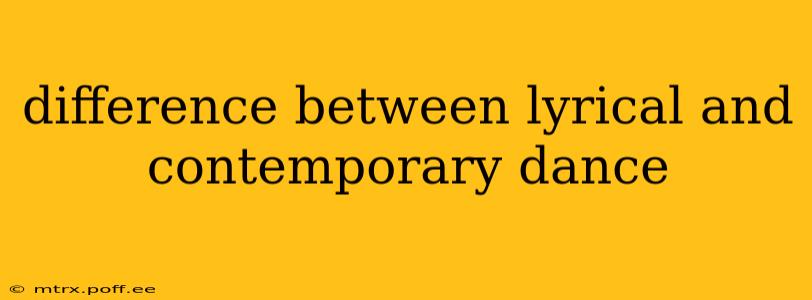Dance, a universal language of movement and expression, encompasses a vast spectrum of styles. Two prominent forms, lyrical and contemporary dance, often overlap, leading to confusion. This article delves into the key differences between these expressive art forms, exploring their techniques, origins, and emotional impact.
What is Lyrical Dance?
Lyrical dance, a subgenre of modern dance, is characterized by its emotional storytelling through fluid, expressive movements. It heavily incorporates elements of ballet, jazz, and modern dance, creating a style that's both technically demanding and emotionally resonant. The movements are often graceful and flowing, mirroring the ebb and flow of emotions conveyed through the choreography. Music plays a pivotal role in lyrical dance, often employing expressive vocals and melodies to guide the dancer's narrative.
What are the key characteristics of lyrical dance?
- Emphasis on Emotion: The core of lyrical dance is conveying a specific emotion or telling a story through movement. Each gesture, pose, and transition is carefully crafted to elicit a particular feeling from the audience.
- Musicality: Lyrical dance is deeply intertwined with music. Dancers interpret the lyrics, melody, and rhythm to shape their performance.
- Ballet Technique Influence: Lyrical dance draws heavily from ballet, incorporating graceful lines, pointed feet, and controlled movements. This provides a foundation of technical precision and elegance.
- Flexibility and fluidity: Graceful transitions and flowing movements define the aesthetic, showcasing suppleness and fluidity.
What is Contemporary Dance?
Contemporary dance is a broader umbrella term encompassing a range of styles that emerged in the mid-20th century as a reaction against the rigidity of classical ballet. It's characterized by its eclectic nature, borrowing freely from various dance forms such as ballet, modern, jazz, and even martial arts. While emotion is certainly a component, contemporary dance is often more focused on exploring movement itself as a form of expression. It prioritizes innovation and pushing creative boundaries.
What are the key characteristics of contemporary dance?
- Eclecticism: Contemporary dance blends diverse techniques and influences, often resulting in a unique and experimental style. It isn't confined by strict rules or traditional forms.
- Focus on Movement Quality: Contemporary dance often emphasizes the quality of movement over specific steps. The emphasis is on exploring different dynamics, weight shifts, and body articulation.
- Floor Work: Contemporary dance frequently incorporates floor work, utilizing the floor as a canvas for movement and expression.
- Improvisation: While many pieces are choreographed, improvisation plays a significant role in contemporary dance, allowing dancers to explore their creativity and individuality.
What is the difference between lyrical and contemporary dance?
While both lyrical and contemporary dance express emotion through movement, their approaches differ significantly. Lyrical dance is a more narrative and emotionally driven style, directly reflecting the music's lyrics and melody. Contemporary dance, while capable of expressing emotion, is broader and more experimental, prioritizing innovation in movement and technique over strict adherence to narrative.
How do their techniques differ?
Lyrical dance frequently uses ballet-based technique as its foundation, leading to a more graceful and flowing aesthetic. Contemporary dance techniques are much more diverse and often incorporate elements of modern, jazz, and release techniques. Floor work is more prevalent in contemporary dance than in lyrical.
Which is harder to learn?
The difficulty of learning either style depends on the individual's prior dance experience and natural aptitude. Lyrical dance might present a steeper learning curve for those without a ballet background due to its emphasis on precise lines and technique. Contemporary dance's eclectic nature can be challenging because it requires adaptability and openness to diverse approaches.
Which style is better?
There's no objectively "better" style; the preference depends entirely on personal taste and artistic goals. If you are drawn to emotional storytelling through fluid movement and possess a foundation in ballet, lyrical dance might be a better fit. If you prefer innovation, experimentation, and a broader movement vocabulary, contemporary dance may be more appealing. Both styles offer unique opportunities for artistic expression and personal growth.
